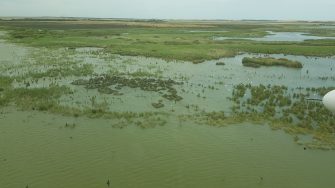
Date: Thursday, November 1, 2018
Project: Eastern Australian Waterbird Survey
Observer: Richard Kingsford
We got up early again to make sure we capitalised on whatever still cool air was around. It was great early but got hot and windy later, meaning our plane bounced around a bit more. From Mildura, we headed north to the town of Wentworth, at the junction of the River Murray and the Darling River.
Sunrise at Mildura
The junction of the Darling (top) and the River Murray at the town of Wentworth.
We flew past Lock 10. These locks control water for irrigation and navigation of houseboats but were originally built to make sure the wool barges could get up and down the river. Then we flew down the main channel of the River Murray, which is wide here. There were perhaps a few more wood ducks around but not that many – the river had its usual numbers of cormorants and pelicans.
Surveying the River Murray west of the town of Wentworth
We continued to survey the billabongs on either side of the river. Many were dry for the first time in the last decade. They often had their relatively small complement of shelduck, pelicans and cormorants. We eventually reached the Chowilla floodplain which has a series of lakes to the north. Many of these were dry but there was some with a bit of water which was drying back, although surprisingly not that many waterbirds.
Surveying Clover Lake on the Chowilla floodplain
Lake Woolpolool was drying back but its shallow areas had a few hundred waterbirds.
Emus had moved onto some of the drying lake beds.
This part of the River Murray is punctuated by locks which are also useful survey sections for our survey. We define lengths of the river by the sections between the locks and get a count of waterbirds for each of the sections.
One of the many locks on this part of the lower River Murray.
One of the more productive wetlands for waterbirds was an evaporation basin, a wetland where highly salty water is stored. This allows a range of invertebrates to thrive and aquatic vegetation to grow. This wetland always has lots of waterbirds and today was no different with hundreds of avocets, grey teak and pink-eared ducks. We then surveyed a series of lagoons on the southern part of the river. Many of these were the lowest that I have seen them during about a decade of this survey. One was Watchells Lagoon where there was a small colony of straw-necked ibis and Australian white ibis.
Surveying the salt evaporation basins.
Surveying a small colony of straw-necked ibis and Australian white ibis on one of the lagoons on the River Murray.
From here we headed for the big lakes – the massive areas of wetland called the Lower Lakes, Lake Alexandrina and Lake Albert. These vast bodies of water always take a long time to survey. They are hard work, taking a lot of concentration as birds come up from everywhere. This is easily balanced by their amazing numbers of waterbirds. We surveyed both lakes once today. We always count the lakes counter clockwise, following their edges, including the most western edge where barrages separate the lakes from the salty water from the sea and the Coorong. Lake Alexandrina had thousands of waterbirds, mostly fish-eating birds such as great cormorants and pelicans. As is usual, there were also a few colonies of waterbirds, including several colonies of straw-necked ibis on the two lakes.
Hundreds of cormorants take off on Lake Alexandrina
Surveying along the barrage, separating Lake Alexandrina from the Coorong
Surveying one of the colonies of straw-necked ibis on Lake Alexandrina
We finished our day and stayed overnight at Goolwa.
